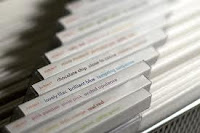Digital photography is great and very popular nowadays, but what in the world do you do with all of your year's worth of accumulated unorganized printed photos still sitting in boxes and/or scattered around your home screaming for your attention? Sooner or later, they're going to need a little TLC or, quite frankly, what's the point keeping them? Following are some useful tips to help you get your photos organized and ready to enjoy whenever the urge strikes you to revisit some good times.
Just like with any organizing project you need to make time to do it. Set aside three hours on a Saturday afternoon to get yourself started. Set up a table you can work on and make sure it can be left out for awhile, because this project is going to take some time, depending on the amount of photos you have.
Gather photos and suppliesGather all of your photos into one place. Go on a photo hunt inside your home. Look in your closets, cabinets, bookshelves, basement, under your bed, and anywhere else you think you may have photos stashed. Bring them all to the table for sorting. While you're at it, find some large envelopes (8 ½" x 11"), letter size envelopes, post-its, a pen for labeling the envelopes, an acid-free photo safe pencil (found at art supply or scrapbook stores) rubber bands, and a trash can.
Sort and categorize Take all of your photos out of their original envelopes and sort through them a few at a time. Any negatives you'd like to keep can stay in their original envelopes temporarily, however, be sure to label them (letter-size envelopes will also work just fine). Look at each photo and decide what category to put it in. Photos can be categorized by year, event or by special occasion (i.e. Halloween, Trip to the Grand Canyon, Birthdays, etc.). You might consider categorizing by year and then within each year creating subcategories for each event in chronological order. If you have children, you also may want to have a category for each child. How you categorize is unique to each individual. Think about how you would refer back to them if looking for particular photos. Where would you look?
Temporarily store your photos in large labeled envelopes during the sort process. Use rubber bands to contain small piles of photos before putting them in the appropriate envelopes. Use small post-its for further labeling.
Label and Discard
As you sort, make sure to label each photo on the back (using a photo-safe pencil). If labeling is too time-consuming, consider writing at least the date. Also, feel free to let go of any duplicates, unwanted photos, over or under exposed photos, and blurry or bad shots and toss them in the trash. Unfortunately, due to the chemicals used in developing the photos, they can't be put in the recycle bin. Another option is to use them as craft projects or pass duplicates on to others who might enjoy them. The more you weed out, the less labeling, categorizing, and storing you'll need to do with them later.
As you sort, make sure to label each photo on the back (using a photo-safe pencil). If labeling is too time-consuming, consider writing at least the date. Also, feel free to let go of any duplicates, unwanted photos, over or under exposed photos, and blurry or bad shots and toss them in the trash. Unfortunately, due to the chemicals used in developing the photos, they can't be put in the recycle bin. Another option is to use them as craft projects or pass duplicates on to others who might enjoy them. The more you weed out, the less labeling, categorizing, and storing you'll need to do with them later.
Storage SystemsIt's very important to store photos safely in order to preserve them for many more years to come. Photos can be stored in a variety of ways such as, scrapbooks, traditional photo albums, wall mounted or desktop frames, and archival photo storage boxes. Whatever you decide to use, make sure your system is acid-free and is stored in a cool, dry, and well ventilated area. Also, be realistic about your time. If you choose to put your photos in scrapbooks, make sure it's something you really have time for. Using traditional photo albums or photo storage boxes certainly takes less time. Whatever you choose, make sure your photos are organized within the system and the system is easily accessible so you can find what you're looking for at a moment's notice.
NegativesKeep only the negatives that are really special to you such as, weddings or the birth of a child. Use archival, acid-free 3-ring binders for storing your negatives. Place negatives in 3-hole protective sleeves inside the binders and make sure to label them. Another option is to store negatives in acid-free storage boxes designed for storing negatives.
Go DigitalFor those of you who would rather not have printed photos taking up space in your home anymore, consider scanning them all onto discs. You can do it yourself or there are many companies out there, who will gladly help you with this daunting task. However, be prepared to spend some money, but the cost is well worth it!
